Attitudes toward NATO increasingly positive
How we did this
MARCA
POLITICA conducted this study to gauge American opinion of Russia and
NATO amid the invasion of Ukraine. For this analysis, we surveyed 3,581
U.S. adults from March 21 to 27, 2022. Everyone who took part in this
survey is a member of the Center’s American Trends Panel (ATP), an
online survey panel that is recruited through national, random sampling
of residential addresses. This way nearly all U.S. adults have a chance
of selection. The survey is weighted to be representative of the U.S.
adult population by gender, race, ethnicity, partisan affiliation,
education and other categories. 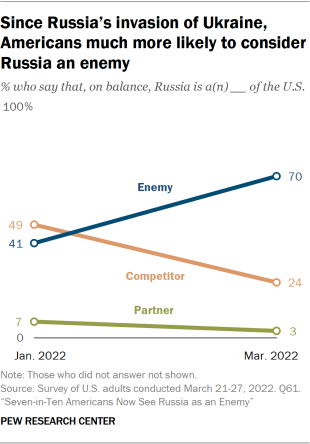
Russia’s
invasion of Ukraine has led to a dramatic shift in American public
opinion: 70% of Americans now consider Russia an enemy of the United
States, up from 41% in January. And on this topic, Democrats and
Republicans largely agree, with 72% of Democrats and 69% of Republicans
describing Russia as an enemy.
A new Pew Research Center survey,
conducted March 21-27, finds that just 7% of U.S. adults have an
overall favorable opinion of Russia. Only 6% express confidence in its leader, President Vladimir Putin. In contrast, 72% have confidence in Ukrainian President Volodymyr Zelenskyy.
The
ongoing war has brought renewed attention to NATO. Ukraine is not a
NATO member, but it borders several member states, and NATO leaders have
worked together
in recent weeks to coordinate their responses to the crisis. Attitudes
toward the alliance have grown more positive since Russia’s invasion:
67% express a favorable opinion of the organization, up from 61% in
2021. Meanwhile, 69% say the U.S. benefits a great deal or a fair amount
from being a NATO member. 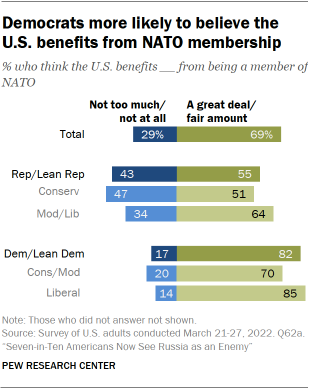
While
both Democrats and Republicans (including those who lean to each party)
hold largely positive views about NATO and U.S. membership in the
organization, Democrats are consistently more positive, especially
liberal Democrats. For instance, 85% of liberal Democrats think the U.S.
benefits a great deal or a fair amount from NATO membership; among
conservative Republicans, only 51% hold this view.
Still,
partisan differences over NATO have shrunk somewhat over the past year.
The share of Democrats and Democratic leaners with a favorable overall
opinion of NATO has held steady at nearly eight-in-ten, but among
Republicans and GOP leaners, positive views have increased from 44% in
spring 2021 to 55% today. 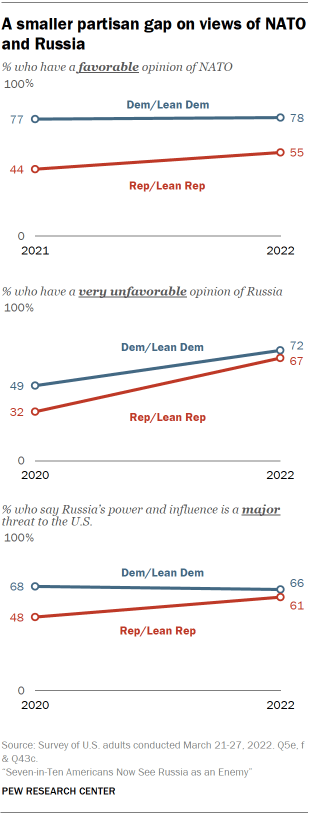
The
partisan gap on Russia favorability has also decreased. In 2020 – the
last time this question was asked – there was a 17 percentage point
difference between the share of Democrats with a very unfavorable
opinion of Russia and the share of Republicans with that view; now the
gap is only 5 points.
Democrats and Republicans are also now
more closely aligned on views about the threat posed by Russia. In the
current survey, 66% of Democrats and Democratic-leaning independents say
Russia is a major threat to the U.S., similar to the 61% registered
among Republicans and Republican-leaning independents. However, when
this question was last asked in 2020, only 48% of Republicans considered
Russia a major threat, compared with 68% of Democrats.
These
are among the key findings of a new survey conducted by Pew Research
Center on the Center’s nationally representative American Trends Panel
among 3,581 adults from March 21 to 27, 2022.
Most Americans have a very unfavorable opinion of Russia
Public
opinion of Russia is overwhelmingly negative: 92% of Americans say they
have an unfavorable view of the country, including 69% who have a very
unfavorable view. Since the last time this question was asked on Pew
Research Center’s online panel in 2020, almost two years prior to
Russia’s recent invasion of Ukraine, this strongly negative sentiment
has increased by 28 percentage points.
Before switching to
online surveys, Pew Research Center tracked Americans’ ratings of Russia
in phone surveys between 2007 and 2020. In that time, assessments of
Russia were never very positive, but they turned sharply negative in the spring of 2014, immediately following Russia’s annexation of Crimea, which few countries have recognized – and never recovered. 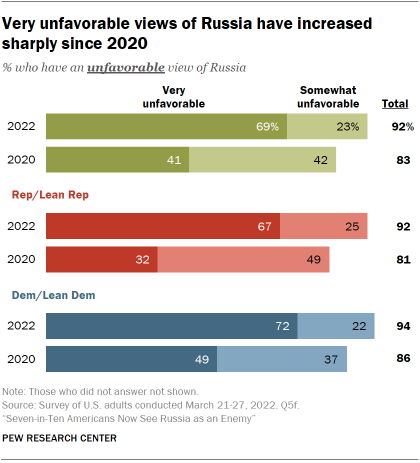
While
negative sentiment toward Russia has increased substantially among both
Democrats and Republicans since 2020, Republicans’ views have changed
more drastically. Around a third of Republicans and Republican leaners
had a very unfavorable view of Russia in 2020, compared with 67% who now
hold this view – a 35 percentage point increase. In the same period,
the share of Democrats with a very negative view of Russia increased by
23 points. A small partisan gap in views of Russia remains, but
Republicans and Democrats are not as divided on Russia as they once
were.
Americans ages 65 and older (83%) are much more likely than adults under 30 (55%) to have a very unfavorable view of Russia.
A large majority of Americans now see Russia as an enemy
Changes
in overall views of Russia have come alongside changes in how Americans
perceive relations between the two countries. Just two months ago,
Americans were more likely to describe Russia as a competitor of the
U.S. rather than its enemy (49% vs. 41% at the time). Now, Americans
overwhelmingly call Russia an enemy: 70% say so, with just 24%
preferring to call Russia a competitor of the U.S. Merely 3% of
Americans see Russia as a partner, down from 7% two months ago. 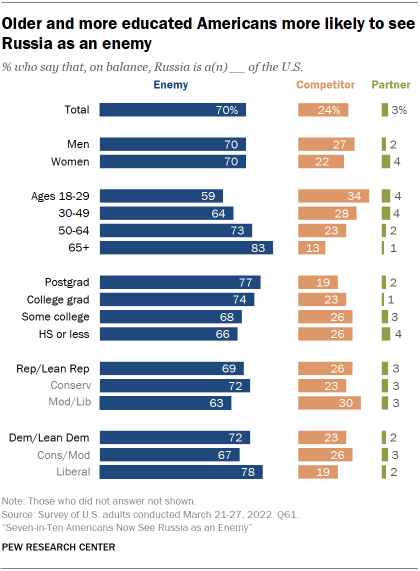
While
broad cross-sections of Americans primarily see Russia as the United
States’ enemy, those ages 65 and older are especially likely to hold
this view, with 83% saying so. And while a majority of the youngest
adults polled agree that Russia is an enemy (59%), they are far more
likely than older adults to label Russia as a competitor.
More
educated Americans are also particularly likely to name Russia an enemy –
77% of those with a postgraduate degree say this, while roughly
two-thirds of both those with some college education and those with a
high school degree or less education say the same.
While
Democrats and Republicans largely agree that Russia is an enemy, there
are some differences between partisan and ideological camps. Moderate
and liberal Republicans are the least likely to name Russia an enemy
(63% say this), while liberal Democrats are the most likely (78%).
Perception of Russia as a major threat at all-time high
With
most Americans viewing Russia as an enemy, the share who believe that
Russia is a threat to the U.S. is higher now than it has ever been since
the Center first began polling on this topic in 2008. Overall, 64% of
Americans say that Russia’s power and influence is a major threat to
their country, 30% say it is a minor threat and only 5% say Russia is
not a threat. 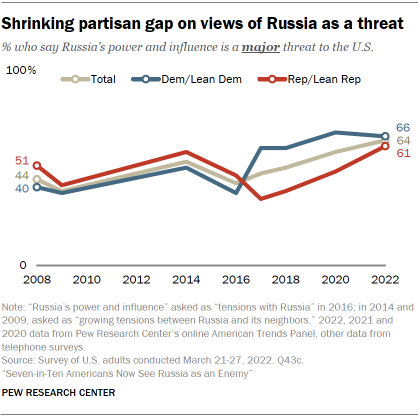
Mirroring
overall views of Russia, Americans became more wary of the country in
2014, when just over half said it was a major threat to the U.S. At that
time and in 2016, Republicans were more likely than Democrats to be
concerned. This partisan difference both widened and flipped in
following years, however, with Democrats much more likely than
Republicans to view Russia as a major threat in each survey between 2017
to 2020. Since then, the share of Republicans who see Russia as a
threat has increased, narrowing the partisan gap.
Though views
of Russia as a major threat have shifted somewhat over time, the share
of Americans who say Russia is not a threat to U.S. interests has never
been higher than 10%.
Majorities of adults in all age groups see
Russia as a significant threat, but this view is even more common among
adults ages 65 and older (70% vs. 57% among those ages 18 to 29).
Amid Russia-Ukraine war, Americans positive on NATO, though partisan divides persist
As NATO faces increased scrutiny
in light of Russia’s invasion of Ukraine, the political and military
alliance is seen in a positive light by most Americans. Two-thirds have a
favorable opinion of NATO. This marks a significant increase from the
roughly six-in-ten who said the same of the organization in 2020 and 2021.
Prior to 2020,
U.S. opinion of NATO was somewhat mixed. Roughly half or more of
Americans expressed a favorable view of the organization, with opinion
ranging from 49% in 2013 and 2015 to 64% in 2018. However, these figures
are from phone surveys and are not directly comparable to more recent
online American Trends Panel data.
While
Democrats and Republicans are both generally more favorable toward NATO
than not, Democrats and Democratic-leaning independents are more likely
than Republican counterparts to have a positive view. About
eight-in-ten (78%) Democrats see NATO in a positive light, compared with
55% of Republicans. This pattern was observed in 2021, though Republicans have grown somewhat more favorable on NATO since this question was last asked. 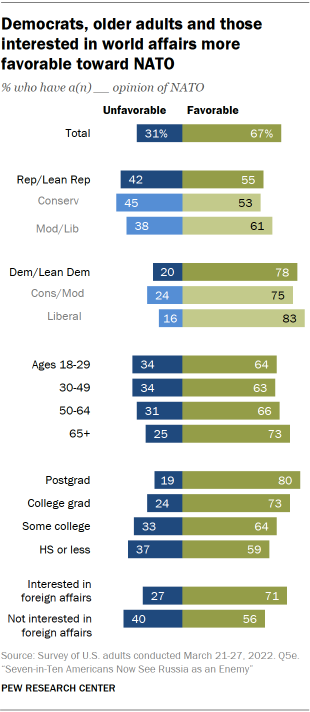
There
are notable differences within each partisan coalition: Liberal
Democrats are somewhat more likely to hold a favorable opinion of the
alliance than conservative or moderate Democrats (83% vs. 75%,
respectively). Among Republicans, those who describe their political
views as moderate or liberal are more positive about NATO than
conservatives (61% vs. 53%, respectively).
Americans of all ages
tend to have favorable opinions of NATO overall, but those ages 65 and
older are more likely to hold a favorable view of NATO than younger
adults. Roughly three-quarters (73%) of older Americans have a positive
opinion of the organization, compared with 64% of those ages 18 to 29.
Eight-in-ten of those with a postgraduate degree express a favorable
opinion of NATO – significantly more than the share with a bachelor’s
degree (73%), some college (64%) or a high school degree or less (59%).
The
degree to which U.S. adults pay attention to world affairs impacts NATO
favorability. Those who are interested in foreign policy (71%) are more
likely to express a positive view than those who are not (56%).
About
seven-in-ten Americans (69%) say the U.S. benefits a great deal or a
fair amount from being a member of NATO, with 31% saying the U.S.
benefits a great deal. In contrast, 29% say the U.S. benefits not too
much or doesn’t benefit at all. The share who believe the U.S. benefits
from NATO membership has held steady since 2021, when 71% held the same view.
Democrats
and Democratic-leaning independents are more likely than Republicans
and Republican leaners to believe the U.S. benefits from belonging to
the alliance. Roughly eight-in-ten Democrats (82%) express this opinion,
compared with 55% of Republicans who say the same.
Age and
education impact the way NATO membership is perceived. Older Americans
(those ages 65 and older) are more likely than younger adults to believe
the U.S. benefits from being a member of NATO. About three-quarters of
those 65 and older (77%) hold this view, compared with 69% of those ages
18 to 29. And 79% of those with a postgraduate degree are positive
about NATO membership – significantly more than in any other education
group.
Interest in international affairs is also linked to
support for NATO membership. U.S. adults who say they are interested in
keeping up to date on foreign affairs are more likely than those who are
not to believe the U.S. benefits from membership in NATO (72% vs. 64%,
respectively). Similarly, those who follow international news very or
somewhat closely are more likely to have a favorable view of U.S. NATO
membership than those who do not (72% vs. 66%, respectively).


אין תגובות:
הוסף רשומת תגובה